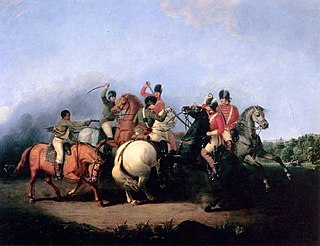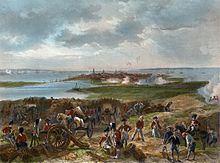
The siege of Savannah or the Second Battle of Savannah was an encounter of the American Revolutionary War (1775–1783) in 1779. The year before, the city of Savannah, Georgia, had been captured by a British expeditionary corps under Lieutenant-Colonel Archibald Campbell. The siege itself consisted of a joint Franco-American attempt to retake Savannah, from September 16 to October 18, 1779. On October 9 a major assault against the British siege works failed. During the attack, Polish nobleman Count Casimir Pulaski, leading the combined cavalry forces on the American side, was mortally wounded. With the failure of the joint attack, the siege was abandoned, and the British remained in control of Savannah until July 1782, near the end of the war.

The Battle of Cowpens was an engagement during the American Revolutionary War fought on January 17, 1781 near the town of Cowpens, South Carolina, between American Patriot forces under Brigadier General Daniel Morgan and British forces, nearly half American Loyalists, under Lieutenant Colonel Banastre Tarleton, as part of the campaign in the Carolinas. The battle was a turning point in the American reconquest of South Carolina from the British.
The 1st North Carolina Regiment of the Continental Army was raised on September 1, 1775, at Wilmington, North Carolina. In January 1776 the organization contained eight companies. Francis Nash was appointed colonel in April 1776. The regiment was present at the defense of Charleston in 1776. It transferred from the Southern Department to George Washington's main army in February 1777. At that time, Thomas Clark became colonel of the 1st Regiment. The regiment became part of General Francis Nash's North Carolina Brigade in July.
The 1st South Carolina Regiment (Infantry) was authorized on June 6, 1775, at Charleston, South Carolina, for service with the South Carolina State Troops. On November 4, 1775, the unit was adopted into the Continental Army and on February 27, 1776 was assigned to the Southern Department. The regiment saw action at the Siege of Savannah and the Siege of Charleston. The British Army captured the regiment at Charleston on May 12, 1780, together with the rest of the Southern Department.
The 3rd South Carolina Regiment was an infantry regiment of the South Carolina Line during the American Revolutionary War. Raised in the western part of South Carolina, the regiment fought in the Siege of Savannah and the Siege of Charleston, surrendering to British forces in the latter.
The Hillsborough District Brigade of militia was an administrative division of the North Carolina militia established on May 4, 1776. Brigadier General Thomas Person was the first commander. Companies from the eight regiments of the brigade were engaged in 55 known battles and skirmishes in North Carolina, South Carolina, and Georgia during the American Revolutionary War. It was active until the end of the war.

The Battle of Ramsour's Mill took place on June 20, 1780 in present-day Lincolnton, North Carolina, during the British campaign to gain control of the southern colonies in the American Revolutionary War. The number of fighters on each side of the battle is still an issue of contention, but Loyalist militiamen outnumbered Patriot militia and had captured a group of Patriots who they were planning to hang on the morning of June 20.

The Battle of Musgrove Mill, August 19, 1780, occurred near a ford of the Enoree River, near the present-day border between Spartanburg, Laurens and Union Counties in South Carolina. During the course of the battle, 200 Patriot militiamen defeated a combined force of approximately 300 Loyalist militiamen and 200 provincial regulars.
Jane Thomas was the wife of John Thomas, a colonel in South Carolina who fought for the rebels in the American Revolution. She passed key intelligence that thwarted an ambush of Whig forces.
Joseph Hardin Sr. was an Assemblyman for the Province of North Carolina, and was a signatory of the Tryon Resolves. Early in the War for Independence, as a member of the militia from Tryon County, Hardin fought the Cherokee allies of Britain along the western frontier. Later in the war, having taken his family over the Appalachian Mountains to the Washington District for safety against the advance of the Red Coats out of South Carolina, Hardin joined the Overmountain Men. He saw action at the Battle of Ramsour's Mill and the decisive Battle of Kings Mountain. Following the peace with Britain, Hardin was a co-founder and second Speaker of the House for the State of Franklin; and an Assemblyman in the Southwest Territory before its statehood as Tennessee.
The Salisbury District Brigade was an administrative division of the North Carolina militia during the American Revolutionary War (1776–1783). This unit was established by the Fourth North Carolina Provincial Congress on May 4, 1776, and disbanded at the end of the war.
The Anson County Regiment was authorized on September 9, 1775 by the Third North Carolina Provincial Congress. The regiment was engaged in battles and skirmishes against the British and Cherokee during the American Revolution in North Carolina, South Carolina and Georgia between 1776 and 1781. It was active until the end of the war.
The Rutherford County Regiment was authorized on October 30, 1779, by the Province of North Carolina Congress. It was created at the same time that Rutherford County, North Carolina was created out of the western part of Tryon County, North Carolina when Tryon County and its regiment of militia were abolished. Officers were appointed and commissioned by the Governor. The regiment was engaged in battles and skirmishes against the British during the American Revolution in North Carolina, Georgia, and South Carolina between 1779 and 1782. It was active until the end of the war.
The Mecklenburg County Regiment was authorized on May 31, 1775 by the Province of North Carolina Congress. From November 7, 1779 until the 3rd Quarter of 1780, it was called the 1st Mecklenburg County Regiment when a 2nd Mecklenburg County Regiment existed. The 1st Mecklenburg County regiment was engaged in 39 known battles and skirmishes against the British during the American Revolution in North Carolina, South Carolina and Georgia between 1776 and 1781. It was active until the end of the war.
The Edenton District Brigade was an administrative division of the North Carolina militia during the American Revolutionary War (1776–1783). This unit was established by the North Carolina Provincial Congress on May 4, 1776, and disbanded at the end of the war.
The Wilmington District Brigade was an administrative division of the North Carolina militia during the American Revolutionary War (1776–1783). This unit was established by the North Carolina Provincial Congress on May 4, 1776, and disbanded at the end of the war.
The New Bern District Brigade was an administrative division of the North Carolina militia during the American Revolutionary War (1776–1783). This unit was established by the North Carolina Provincial Congress on May 4, 1776, and disbanded at the end of the war.
North Carolina state troops in the American Revolution were the initial military units created in a transition from the Province of North Carolina under British rule to independence from British rule. Most units did not last long as such and were either transferred to the Continental Army or state militia instead.
John Thomas, Sr. was a colonel during the American Revolutionary War who led the Spartan Regiment against the Loyalists. He was a representative of the Provincial Congress in 1776. During the fall of Charleston, Thomas was captured and was imprisoned at the Ninety Six prison and later at Charleston until the end of the war.






